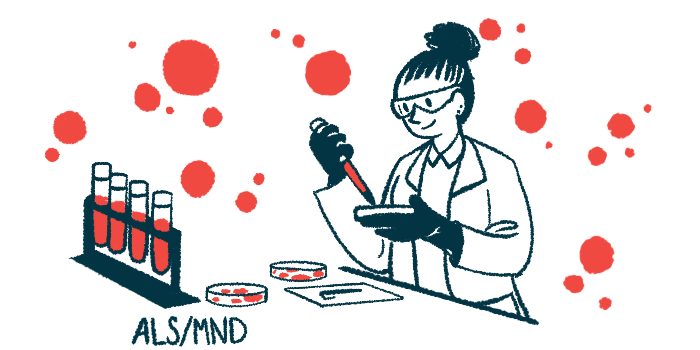ALS/MND 2023: AMX0114 may enter clinical testing next year
New ASO treatment is being tested in preclinical studies toward IND application

Amylyx Pharmaceuticals is developing AMX0114, a new experimental treatment for amyotrophic lateral sclerosis (ALS) that’s designed to promote the health of nerve fibers by lowering levels of calpain-2, a protein.
AMX0114 is being tested in preclinical studies with the aim of supporting an investigational new drug application (IND), a formal request to test it in people. If all goes well, AMX0114 could enter clinical trials as early as 2024.
A team led by scientists at Amylyx presented an update on the therapy’s development at the 34th international symposium on ALS and motor neuron disease (MND), Dec. 6-8, in Basel, Switzerland and online. Their poster was titled, “Update on AMX0114: An Antisense Oligonucleotide Targeting Calpain-2, a Critical Effector of Axonal Degeneration.”
Amylyx is also the maker of Relyvrio (sodium phenylbutyrate and taurursodiol), formerly known as AMX0035. The oral therapy is approved to treat ALS in the U.S. and Canada, where it’s sold as Albrioza.
“AMX0114 is intended to potentially complement AMX0035. We believe that it is going to take a combination approach, targeting multiple cellular pathways implicated in disease pathogenesis [disease development], to find a cure for ALS,” Evan Mizerak, lead of preclinical research at Amylyx Pharmaceuticals, said in an email to ALS News Today.
ALS is marked by the progressive death of motor neurons, the specialized nerve cells that control voluntary movement. While the precise causes of ALS are not fully understood, its progression involves the degeneration of the long, wire-like extensions, called axons, that nerve cells use to send electrical signals. Reducing axonal degeneration may slow the disease’s progression.
Reducing calpain-2 levels
Calpain-2 is a protease, a protein that’s able to chop up and destroy certain other proteins. It plays an active role in the degeneration of axons, and experiments in animal models and nerve tissue from deceased patients indicate its activity is high in ALS.
“Calpain-2 activation has been shown in the scientific literature to be a key executioner of axonal degeneration (also known as Wallerian degeneration), a process that has been increasingly recognized as a key early contributor to the pathogenesis and clinical presentation of ALS and other neurodegenerative diseases,” said Mizerak, an author on the poster presentation.
AMX0114, which belongs to a class of medications called antisense oligonucleotides (ASOs), is designed to reduce calpain-2 levels by interfering with its production in cells. Reducing the protein is expected to check axonal degeneration.
Data presented last year were consistent with this idea and showed AMX0114 decreased the degeneration of nerve fibers in cell experiments where nerve cells were exposed to toxic chemicals.
AMX0114 chosen as best potential ASO treatment
ASO treatments like AMX0114 bind to and destroy messenger RNA (mRNA), an intermediary molecule that’s produced as part of the process of making new proteins in cells. AMX0114 targets mRNA from the CAPN2 gene, which provides instructions for making calpain-2.
At the ALS/MND symposium, researchers shared data on how AMX0114 was selected as a therapeutic candidate after dozens of ASO-based therapies designed to reduce calpain-2 production were tested. AMX0114 showed the best potential, reducing CAPN2 mRNA levels by 72%, nearly twice as much as the next best candidate, without any added toxicity to nerve cells.
While the greatest reduction in CAPN2 mRNA levels was observed about two days after treatment with AMX0114 (a 94% reduction), the effects were long-lived, with mRNA levels remaining 77% lower than normal three weeks after the therapy was withdrawn.
The therapy’s impact on calpain-2 levels took longer to become evident, with the protein reaching its lowest levels (51% lower than normal) two weeks after treatment. Levels then remained stable throughout the study, up to day 21.
“The extent of knockdown conferred by AMX0114 exhibits little decrease over time, suggesting a durable effect,” wrote the researchers who noted the data will help determine the therapy’s dose in living animal studies.
“AMX0114 is currently in investigational new drug (IND)-enabling studies, potentially allowing for initiation of a first-in-human study during 2024,” Mizerak said.







